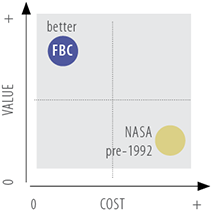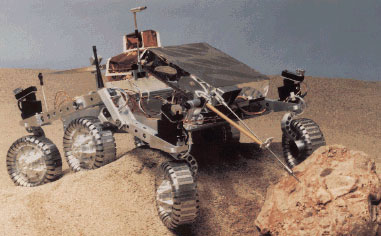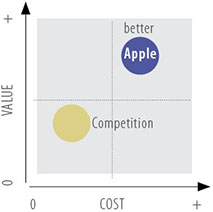
How do we know when something is better? When we have options, we tend to go with the better choice. Better is always comparative, departing from an assumed benchmark. It is most commonly encountered as the middle level of available alternatives: good – better – best. Good is the baseline, and better nearly always costs more than good. But the superlative, best, commands the highest price in return for its expected superior qualities. Culturally, better seems to represent the soft middle ground, with the promise of improvement or greater value.

“Save Money, Live Better,” – Walmart’s catch phrase, casts better as a natural consequence of frugality. You don’t pay more for this flavor of better because its happens automatically. Walmart has even created a “Live Better Index” (honestly), which attempts to justify what better means for their customers – lower costs and a nod to sustainability. The claim of the Living Better Index is the equation: Living Better = Saving Money. What better might consist of beyond saving money seems to be outside of Walmart’s vision.
NASA – Faster, Better, Cheaper (FBC)
There have been attempts to harness better as part of a true decision-making process. The FBC approach was erected by NASA in the early 1990’s as an attempt to create a new framework for change. This was a radical new paradigm within NASA that sought to significantly reduce the cost and time needed to undertake space missions and research projects. FBC is really an unbundling of the general idea of better – where faster and cheaper are the two universal attributes residing within the term better.

Once NASA instituted FBC, mission costs and time frames did drop dramatically – an order of magnitude really. Projects routinely cost less than 10% of their predecessors, and were completed in a fraction of the time. NASA even developed a working definition:
Better = 50% of mission requirements fulfilled @10% of cost.

The most prominent success story of this program was the Mars Pathfinder mission. By switching from requirements-driven to capability-driven design, goals and costs were established as the controlling inputs to design, providing NASA engineers with a methodology for succeeding at better, so long as faster and cheaper were also met. But there were significant difficulties in balancing the FBC equation. After 4 out of 5 missions crashed and burned in 1999, the FBC approach was superseded in order to find new ways to improve outcomes.
Apple

An entirely different facet of better is evident in the emergence – and current dominance – of the Apple brand. While not faster, cheaper, or more technologically adept than other available technologies, Apple has risen to success by controlling nearly every aspect of the user experience, leading to products and interactions that – for now – effectively have no competition. The Apple equation for better is: Better = unrivaled customer experience.
Architecture
Architectural practice in many ways parallels the FBC approach to value. We don’t call it FBC, but the performance metrics sure look the same:
- Faster: amplifies Cheaper. In practical terms, is its really an economic metric – the more quickly a project can be implemented, the better the financial return.
- Better: as with NASA, it is a placeholder for everything else that happens to the good, or that is prevented from happening if it’s bad. Better is the feeling that improvement has occurred over some real or imagined benchmark of expectations.
- Cheaper: the capital, operational, and environmental costs taken together, where the optimal solution puts these into an affordable and societal balance.
As architects, we focus on people and what they need to be successful. These examples of better are instructive because they provide us with insights into how we can shape the design and decision-making processes to result in better outcomes. Faster and cheaper are the booster rockets that launch solutions. Better is the payload.